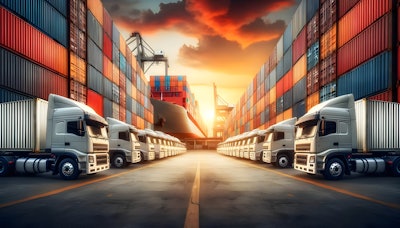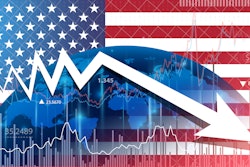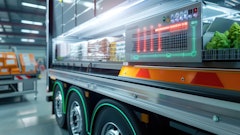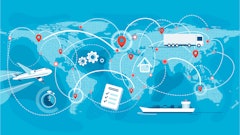
What a time to work in the supply chain industry. From port strikes and rail strikes to environmental, social, governance (ESG) regulations, electrification mandates and natural disasters shutting down major roads and ports, it’s a wonder any food and beverage moves through the cold chain.
But have no fear, it’s not all doom and gloom.
Food Logistics talks exclusively with Hamish Woodrow, head of strategic analytics at Motive, about nearshoring, transportation and why supply chain managers must adapt to flexibility.
CLICK HERE to read the full article.
Food Logistics: From your perspective, what are considered the Top 5 trends to watch in 2025? And why?
Hamish Woodrow: Mexico cementing itself as our largest trading partner. Nearshoring has been happening in earnest for a few years now, but what’s fascinating is that it has largely been immune from the effects of things like the pandemic and other disruptions that have affected other elements of the supply chain.
On a related note, a decrease in imports from eastern Asia, specifically China. Though there are some fluctuations based on consumer demand, the decrease in imports from China generally is a big shift that will likely continue regardless of factors like who wins in the 2024 elections or labor disputes like ILA strikes that recently were in the news.
The trucking market moving toward positive growth, or more new carriers entering the market than those exiting it. This is one that has actually slowed down in recent months, but we expect the holidays to bring the momentum back and bring positive growth for the market in early 2025. If consumer demand holds it could mean a very strong market for trucking in the short term.
What rising shipping costs mean for retailers and consumers. The flip side of the trucking market getting stronger is that rising trucking rates will mean it’s more expensive to ship goods. This was already happening heading into the holidays, and soon retailers won’t be able to prevent their prices from going higher as they’ll need to pass these costs to consumers
Retailer restocking. One of the things we highlight each month in our Monthly Economic Report are trends in retailer restocking, or what inventory levels look like based on warehousing data. This can help predict consumer demand and how retailers are thinking about that demand.
Food Logistics: Describe some of the challenges impacting many of today’s supply chains. This can include everything from port/rail strikes and ESG regulations to adopting technologies and more.
Woodrow: Supply chain disruption is really becoming normalized. From the huge spike in demand during the pandemic to the various geopolitical and labor elements that have become more and more prevalent in recent years, shippers and carriers alike are starting to see these disruptions as the new normal. The biggest challenge now is being flexible enough to adapt to these changes quickly, while still keeping up with demand. Shippers adapting their supply chain is incredibly challenging, but also more necessary than ever.
Food Logistics: Describe the State of Transportation, and how factors such as port/rail strikes, electrification, trucking wages, trucking mandates, and more will affect the State of Transportation in 2024.
Woodrow: As I mentioned before, I think transportation overall is heading in a positive direction. Rates are rising, inflation seems to be trending toward cooling, and we have likely reached the bottom of the trucking market’s negative growth and are moving in the other direction. Retailers are anticipating consumer demand over the holidays to be strong (even potentially record-setting), and if that’s the case we’ll see transportation (and specifically trucking) get a big boost on its way to positive growth again.
Food Logistics: The global container shipping industry continues to witness an increase in freight demand for U.S.-bound shipments. What does this mean? And what will this look like come 2025?
Woodrow: Again we can look to consumer demand as a potential leading indicator here. Retailers are bringing in more goods because the anticipation (especially with the ILA strikes largely averted) is that demand will remain very strong in Q4. This could, in turn, lead the typical Q1 dip in 2025 to not be as severe, and set up freight demand to continue to trend up and to the right.
Food Logistics: Let’s talk State of Software and Technology. What kinds of emerging technologies are your company/your customers/your members implementing to improve resilience, transparency and visibility?
Woodrow: Motive empowers the people who run physical operations with tools to make their work safer, more productive, and more profitable. For the first time ever, safety, operations and finance teams can manage their drivers, vehicles, equipment, and fleet related spend in a single system. Combined with industry leading AI, the Motive platform gives you complete visibility and control, and significantly reduces manual workloads by automating and simplifying tasks. Our customers are finding this hugely valuable because as their work becomes harder and more dangerous, innovations like these can help them and their workers stay safe, and make their operations more efficient and profitable.
Food Logistics: Let’s talk ESG regulations. Sustainability reporting is a big thing to come in 2025. Walk us through the steps your company/your customers/your members are taking to ensure ESG compliance.
Woodrow: Our fleet fuel management and reporting on utilization, maintenance issues, battery utilization and idling events not only improves efficiency and cost, but helps fleets operate in the most environmentally responsible way possible. Leveraging Motive’s real-time GPS updates and geofencing, live traffic and weather overlays, and historical activity tracking, as well as visual data from Motive’s AI-powered cameras, make for a safer, higher-performing fleet on the road. But it all comes back to how this information is taken in and turned into actionable insights. Motive’s engineering team uses machine learning, intelligent automation, and pre-built third-party integrations to deliver this data to get more done with better efficiency, and in less time.
Food Logistics: How do other more global events such as the Russia/Ukraine War, hurricanes, the Red Sea attacks and more impact U.S. global supply chains? What is the outlook for 2025?
Woodrow: As I mentioned before, disruptions like these will become a more regular factor that supply chain managers must adapt to. It is tough to predict what will hit in 2025, but what can be predicted is that flexibility must be built into planning to account for these kinds of disruptions.
CLICK HERE to read the full article.



















